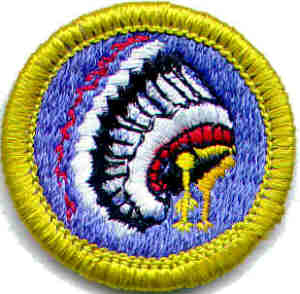
Indian Lore
- Give the history of one American Indian tribe, group, or nation that lives or has lived near you. Visit it, if possible. Tell about dwellings, kind of life, tribal government, religious beliefs, family and clan relationships, language, dress, food preparation, means of getting around, how they played, if they were warlike or peaceful, where descendants of the group now live, and how they live.
- Do TWO of the following. Use information about a
specific group or tribe to complete the
requirements:
- Make an item of clothing worn by a member of the tribe.
- Make and decorate three items approved by your counselor used by the tribe.
- Make an authentic model of a dwelling used by any Indian tribe, group, or nation.
- Visit a museum to see Indian artifacts. Talk about them with your counselor. Identify at least ten artifacts by tribe or nation, their shape, size, and use.
- Do ONE of the following:
- Learn three games played by a group or tribe. Teach and lead one game with a Scout group.
- Learn and show how a tribe cooked or prepared food. Make three food items.
- Give a demonstration showing how a specific Indian group hunted, fished, or trapped.
- Do ONE of the following:
- Write or briefly describe how life would have been different for the European settlers if there had been no Indians to meet them when they came to this continent.
- Sing two songs in an Indian language. Explain their meaning.
- Learn in an Indian language at least twenty-five common terms and their meanings.
- Show twenty-five signs in Indian sign language. Include those that will help you ask for water, food, and where the path or road leads.
- Learn in English an Indian story of at least three hundred words, or any number of shorter stories adding up to three hundred words. Tell the story or stories at a Scout meeting or campfire.
- Write or tell about eight things adopted by others from the Indians.
- Learn twenty-five Indian place-names. Tell their origins and meanings.
- Name five well-known American Indian leaders, either from the past or people who are alive today. Give their tribes or nations. Describe what they did or do now that makes them notable.
- Learn about the Iroquois Confederacy, including how and why it was formed. Tell about its governing system, and its importance to the framers of our Constitution.

Insect Study
- Tell how insects are different from all other animals. Show the differences among insects, centipedes, and spiders.
- Point out and name the main parts of an insect.
- Collect and mount 50 different species. Include 6
orders and 18 families of insects. Label each
with common and scientific names where possible.
- NOTE: Some insects are endangered species and are protected by federal and state law. Be sure to check in advance to make sure that anything you collect is not protected.
- Describe the things that distinguish each of the families and orders in your collection.
- Show your collection.
- Compare the life histories of a butterfly and a grasshopper. Tell how they are different.
- Raise a butterfly or moth from a caterpillar.
- Tell the things that make social insects different from solitary insects.
- Collect and watch an ant colony or a beehive. Tell that you saw.
- From your collection, identify:
- Four species of insects helpful to people. Tell how they are helpful.
- Six species of harmful insects. Tell how they can be controlled.
- Tell how insects fit in the food chains of other insects, fish, birds, and mammals.